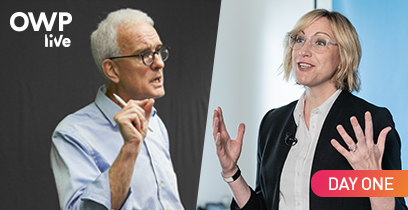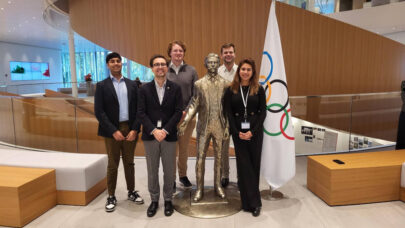How to lead real social and environmental change
Amid global concerns about climate change, food security and supply chains, sustainability is on the agendas of leadership teams and in board rooms. Beyond a moral imperative, it offers a convincing business strategy that can grow a company’s top line by boosting brands, reputation and product differentiation. It can even benefit profitability by saving money.
Antoine de Saint-Affrique, Chief Executive Officer of Barry Callebaut, opened IMD’s Orchestrating Winning Performance program by warning his audience of executives that the business case for sustainability was clear, and should be a driver for them. “Business as usual is just too risky,” he said.
Saint-Affrique described the transformation of the world’s biggest producer of industrial chocolate, which focused on four key elements: farmer prosperity; zero child labour; thriving nature; and sustainable chocolate. It was crucial, he explained, to work in partnerships. Efforts included microcredits and microinsurance to ensure farmers would not stop investing after a poor harvest, and broader social steps, like providing wells and improving schooling.
Sustainability not only addressed consumer demand and boosted the company’s reputation; it also anticipated likely rising regulatory pressure and, potentially spurred innovation. As an example, he pointed out that Barry Callebaut uses formerly discarded shells of cocoa pods as a source of energy in its facilities, with the by-product even serving as fertilizer. The company has launched a new product made entirely of cocoa fruit. “Cocoa is the only fruit where the seeds are used, but the actual fruit is discarded,” said Saint-Affrique.
How companies and talent can gain from a shared purpose
Organizations can improve performance and engagement by embracing a purpose that resonates with employees.
“We start businesses for a reason, they have a purpose,” said David Bach, IMD’s Dean of Innovation and Programs. “If that is formulated around societal needs, engages employees and taps into their own personal purpose, greater performance follows.”
Research shows that companies with a strong purpose perform better on the stock market, and the importance of purpose has only grown during the COVID-19 pandemic. “If you want the best talent, you need to make sure you invest in what drives and motivates them, or else they will leave,” said Alyson Meister, Professor of Leadership and Organizational Behavior at IMD.
Yet there appears to be a purpose deficit in the workplace, with a study showing that 85% of frontline managers and employees are unsure they can live their purpose in their day to day work, or adamant that they can’t.
There are some simple steps that executives can take to better align their corporate purpose with the personal values of today’s talent.
This includes discovering your own sense of purpose to inspire and motivate yourself; connecting to your team’s purpose to understand their motivation; unearthing your organization’s purpose; embedding it throughout the organization and communicating it to all stakeholders, so that your teams feel part of something bigger.
Focus and mobilize your people for leadership with real impact
Even as leaders establish direction and drive accountability, they must energize their people and teams. Striking this balance is a core leadership skill.
It’s important to define a mission and vision, provide clear direction and drive accountability, but also to listen, engage, seek out input and show vulnerabilities. Otherwise, you end up with a staff that is disengaged and disconnected, even burnt out.
A simple decision matrix helps to provide direction and create energy by ranking different options according to pre-established criteria in a transparent manner.
Leaders can further energize staff by creating a sense of fair process: integrating the perspectives of multiple stakeholders, showing that you have thought through the trade-offs, and acknowledging your best decision is not perfect.
“These are skills that are eminently learnable,” said Albrecht Enders, Professor of Strategy and Innovation at IMD, adding that “you’re going to be a much more powerful and impactful leader”.
But you’ll need to strike a balance between aspiration and presence, or striving joylessly towards high performance, likely leading to burnout, versus being grateful for what already is, without aimlessly drifting.
“Getting caught in a state of constant overdrive is a real risk for leaders,” said Michael Watkins, Professor of Leadership and Organizational Change at IMD.
He added that they’re likely to project this pressure onto their team: “You really can’t hope to mobilize, sustain, energize others if you can’t energize yourself on a sustainable basis.”
How to find a perfect match for a successful digital ecosystem
Amazon, Facebook, Microsoft, Apple and Visa all rely heavily on an ecosystem of partners who create and deliver value together. But if one set of partners does not win, the entire ecosystem could fail. So strategizing the appropriate configuration (from product to platform) and scouting out the right partners is vital to the success of ecosystems.
Partnerships have proven to be fruitful for companies such as American Express and Uber, which struck a deal to allow American Express rewards program members in the US to double their points when they pay for an Uber ride.
There are different types of “scouting vehicles” that can support companies in their search for the right match, including incubators, accelerators, business development organizations, and corporate venture capital arms.
Roache, for example, has established a corporate venture fund. Roche Diagnostics, has run co-creation pilots with more than 30 startups through its partnership with Plug and Play, which connects corporations to startups through accelerator programs in Silicon Valley.
Corporate venture capital arms are especially beneficial because they seek synergies with the external startup companies that they invest in, an approach which has been shown to generate significant financial returns.
But establishing a CVC does have its challenges, said James Henderson, IMD Professor of Strategic Management. “They can be slow to make an investment because there are many hoops to jump through,” he explained. “It will take between four and seven years before any returns are seen.”



